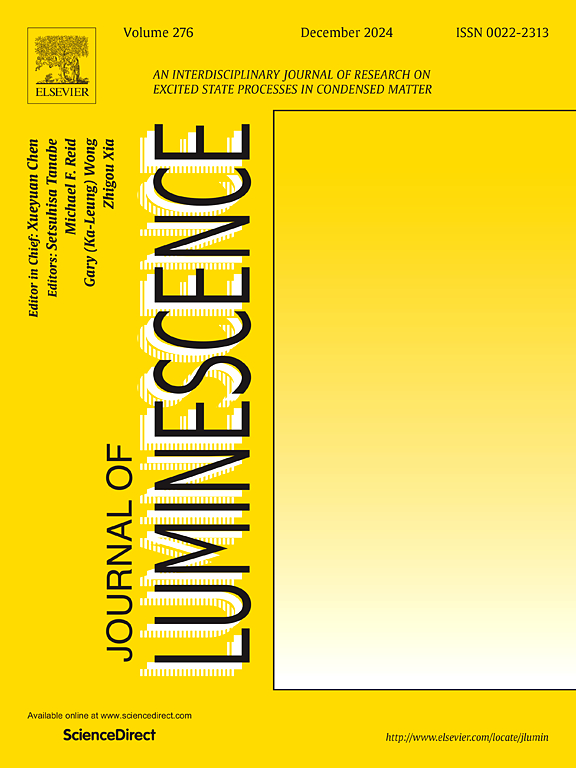Judd-Ofelt analysis and structural, morphological, optical characteristics of Eu3+ doped Ca2GdMO6 (M=Nb, Ta) double perovskite phosphors
IF 3.3
3区 物理与天体物理
Q2 OPTICS
引用次数: 0
Abstract
Rare-earth (RE) activated double perovskite phosphors have emerged as promising candidates for advanced optoelectronic applications due to their superior photoluminescence and high quantum efficiency. In this study, the structural, morphological, and spectroscopic properties of Ca2Gd1-xMO6:xEu3+ (M = Nb, Ta and x = 2.5–50 mol%) double perovskites were systematically investigated to assess their suitability for red-emitting laser phosphor applications. X-ray diffraction (XRD) confirmed a stable single-phase monoclinic structure with successful Eu3+ substitution at Gd3+ sites up to 50 mol% for both host lattices. Scanning electron microscopy (SEM) revealed that Ca2GdNbO6:Eu3+ formed irregular micron-sized grains, while Ca2GdTaO6:Eu3+ developed larger, oval-shaped particles. Photoluminescence measurements showed enhanced emission intensities up to 40 mol% Eu3+, followed by quenching at 50 mol% due to concentration quenching effects. Increasing Eu3+ concentration strengthened the hypersensitive 5D0→7F2 electric dipole transition, reflected in higher asymmetry ratios and increasing Judd–Ofelt parameters (Ω2, Ω4), indicating a gradual reduction in local symmetry and ligand electron density. Notably, Ca2Gd0.6NbO6:0.4Eu3+ exhibited a higher stimulated emission cross-section (71.783 × 10−22 cm2) and optical gain (3.242 × 10−24 cm2 s) compared to its Ta-based counterpart, along with superior quantum efficiency (ηQE = 100 %). Good agreement between theoretical and experimental quantum efficiency values (within 0–6 % deviation) validated the Judd–Ofelt analysis. Chromaticity evaluations demonstrated high color purity (∼95 %) and low correlated color temperatures (CCTs), making these materials attractive for warm white and red-light-emitting devices. Overall, the results underscore the strong red emission, structural tunability, and optical amplification potential of Eu3+-doped Ca2GdNbO6 and Ca2GdTaO6 phosphors, confirming their viability as efficient red laser materials and photonic components.
Eu3+掺杂Ca2GdMO6 (M=Nb, Ta)双钙钛矿荧光粉的Judd-Ofelt分析及结构、形态、光学特性
稀土(RE)激活的双钙钛矿荧光粉由于其优越的光致发光和高量子效率而成为先进光电应用的有希望的候选者。本研究系统地研究了Ca2Gd1-xMO6:xEu3+ (M = Nb, Ta和x = 2.5-50 mol%)双钙钛矿的结构、形态和光谱性质,以评估其作为红发激光荧光粉的适用性。x射线衍射(XRD)证实了一个稳定的单相单斜结构,在两个主晶格的Gd3+位点上成功地取代了Eu3+高达50 mol%。扫描电镜(SEM)显示,Ca2GdNbO6:Eu3+形成不规则的微米级颗粒,而Ca2GdTaO6:Eu3+形成较大的椭圆形颗粒。光致发光测量表明,Eu3+浓度达到40 mol%时,发射强度增强,随后由于浓度猝灭效应在50 mol%时猝灭。增加的Eu3+浓度增强了超敏感的5D0→7F2电偶极子跃迁,反映在更高的不对称比率和增加的Judd-Ofelt参数(Ω2, Ω4),表明局部对称性和配体电子密度逐渐降低。值得注意的是,Ca2Gd0.6NbO6:0.4Eu3+具有更高的受激发射截面(71.783 × 10−22 cm2)和光学增益(3.242 × 10−24 cm2 s),且量子效率更高(ηQE = 100%)。理论量子效率值与实验量子效率值之间的良好一致性(偏差在0 - 6%之间)验证了Judd-Ofelt分析。色度评估显示出高色纯度(~ 95%)和低相关色温(cct),使这些材料对暖白色和红色发光器件具有吸引力。总体而言,结果强调了Eu3+掺杂Ca2GdNbO6和Ca2GdTaO6荧光粉的强红色发射,结构可调性和光学放大潜力,证实了它们作为高效红色激光材料和光子元件的可行性。
本文章由计算机程序翻译,如有差异,请以英文原文为准。
求助全文
约1分钟内获得全文
求助全文
来源期刊

Journal of Luminescence
物理-光学
CiteScore
6.70
自引率
13.90%
发文量
850
审稿时长
3.8 months
期刊介绍:
The purpose of the Journal of Luminescence is to provide a means of communication between scientists in different disciplines who share a common interest in the electronic excited states of molecular, ionic and covalent systems, whether crystalline, amorphous, or liquid.
We invite original papers and reviews on such subjects as: exciton and polariton dynamics, dynamics of localized excited states, energy and charge transport in ordered and disordered systems, radiative and non-radiative recombination, relaxation processes, vibronic interactions in electronic excited states, photochemistry in condensed systems, excited state resonance, double resonance, spin dynamics, selective excitation spectroscopy, hole burning, coherent processes in excited states, (e.g. coherent optical transients, photon echoes, transient gratings), multiphoton processes, optical bistability, photochromism, and new techniques for the study of excited states. This list is not intended to be exhaustive. Papers in the traditional areas of optical spectroscopy (absorption, MCD, luminescence, Raman scattering) are welcome. Papers on applications (phosphors, scintillators, electro- and cathodo-luminescence, radiography, bioimaging, solar energy, energy conversion, etc.) are also welcome if they present results of scientific, rather than only technological interest. However, papers containing purely theoretical results, not related to phenomena in the excited states, as well as papers using luminescence spectroscopy to perform routine analytical chemistry or biochemistry procedures, are outside the scope of the journal. Some exceptions will be possible at the discretion of the editors.
 求助内容:
求助内容: 应助结果提醒方式:
应助结果提醒方式:


